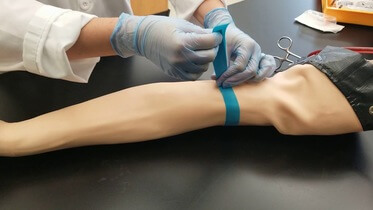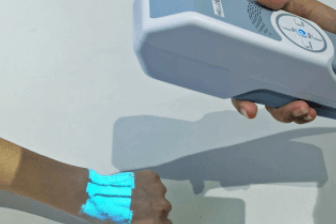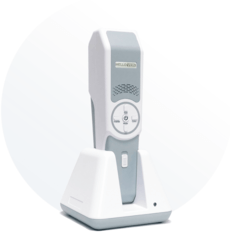When a patient has hard to find veins, blood specimen collection procedures make them the most distressed and uncomfortable. Getting punctured with a needle multiple times makes them angry at the hospital, and at the medical practitioner as well. The primary locations for blood withdrawals are the arms, forearms, and wrists. If the medical practitioner cannot find the veins in such places, then they would try to find other sites to draw blood from.
Here are six important and most practiced methods that will help you to find veins easily.
- Keep The Area Warm
- Use Gravity For Your Benefit
- Enough Hydration
- Relaxation Is Key
- Tourniquets
- Use a Vein Finder
1. Keep The Area Warm

Warming up the body of the patient before putting a needle into their arm is a good idea. The blood flow inside our body increases as the body temperature goes up. This leads to the expansion or largening of veins.
There are several ways to raise your body's temperature. As a medical practitioner, you can rub the area of the intravenous procedure for a few minutes with a heated cotton cloth. Alternately, you can ask the patient to immerse their arm in warm water for a while.
If the vein is still hard to find, you can ask the patient to perform some short but vigorous activities for a few minutes. This will increase the heart rate, which will lead to an increment in the blood flow in the veins. However, do not slap the area as it does not work and only causes discomfort to the patient.
2. Use Gravity For Your Benefit

Using gravity to identify veins sounds uncommon but it is a very common practice. Ask your patient to lie down, make a fist, or knead a soft object while the chosen arm hangs down. The centrifugal force will ensure that the specific arm has a heavy blood flow, as a result, the veins will dilate.
This will lead to a smoother intravenous or cannulation process.
3. Enough Hydration

The most common reason why medical practitioners have a hard time finding the vein of a patient is that the patient is not hydrated enough. Dehydration leads to the veins becoming less visible. When a patient is fully hydrated, their veins become dilated.
As consequence, the blood withdrawal procedure becomes much easier. If you cannot find the veins on your patient’s body, ask them to hydrate properly. You can ask the patient to drink enough water before the transfusion.
4. Relaxation Is Key

When it comes to sticking a needle in their body, not many people can stay calm. Lots of people are terrified of needles, regardless of their age. In addition, the thought of another person sticking a needle in a place inside their body that is not even visible properly can cause breakdowns. It is a common scenario for both kids and adults.
When the patient feels nervous, their veins will get more constricted leading to invisible or hard to find veins. As a medical practitioner, you should try your best to comfort and calm the patient.
5. Tourniquets

Using tourniquets to find a suitable vein is one of the oldest and most commonly practiced technics in the medical field. Injecting becomes much easier when using a tourniquet because of how it works. The veins on the hands become much clearer and larger because they expand when a nurse ties a tourniquet on the patient’s upper arm. When a vein dilates, it also anchors and prevents from rolling about. With a tourniquet, the blood flow inside the arm is unable to leave the arm and only flows inside. So basically, a tourniquet works as a temporary blockage that restricts blood from leaving the veins of an arm, thus expanding or dilating the veins in the process.
However, keep in mind that, before pulling out the needle from the vein, you need to loosen the tourniquet. If you keep a tourniquet on for more than a minute, it can change the number of red cells inside the tourniquet leading to an impact on the test results.
6. Use a Vein Finder

A
vein finder, as the name suggests, is a clinical tool that finds or locates hard to find veins. With the help of this tool, a nurse or doctor can easily find veins that are hard to find with the naked eye. There are basically two types of vein finders. An infrared vein finder is considered the better one between the two.
With the use of a vein finder, you can rapidly locate a patient's vein without causing them unnecessary stress or suffering. This may be especially useful for people who have trouble getting venous access.
When Should You Use A Vein Finder?

Almost every medical practitioner knows how to find a vein, but does everyone have the correct expertise too? The answer in this scenario is, no. Not every nurse has the expertise to find difficult veins without causing discomfort to the patients.
In addition, let us not forget the traditional method of finding a vein in hospitals. Many doctors consider this method unsophisticated although it has been used for many decades now. But times have changed, and the quality of healthcare has evolved too. Thanks to the newer technologies, healthcare has become much easier and simpler for many.
The traditional method of using a tourniquet on the upper arm, while the patient is either kneading a soft object or making a fist to make the veins more visible is no longer needed.
With the usage of a small device called the vein finder, finding the right vein according to the procedure has become much easier.
Any medical practitioners such as nurses, doctors, etc. who perform cannulation, and venepuncture operations, whether for blood withdrawal or intravenous injections, should have access to a vein finder since it is simple to use, and can save a lot of time and improves the quality of service significantly.
HelloVein Max 3.0 Vein Finder

For the past 7 years, HelloVein has been supplying world-class portable vein finders made with cutting-edge technology to hospitals and clinics all over the world. From the beginning, our motto was to reduce the hassles patients face every day in healthcare. And we are proud to say that after 7 years, we are following the journey we once started very successfully.
As a quality-oriented organization, HelloVein always thinks about its customers and puts their satisfaction above anything else. At HelloVein, our goal is to utilize cutting-edge technology and infuse it properly to remove the guesswork out of intravenous or venepuncture procedures entirely.
We are one of the leading suppliers of portable vein finders in the country and have sold our product to the UK, UAE, and more. We have supplied our vein finder in hospitals spread over 100 countries worldwide. In addition, HelloVein has been approved as an ISO13485 quality by Germany TUV Rheinland.
Our vein finder,
HelloVein Max 3.0 is made with state-of-the-art technology that offers all the benefits you could possibly imagine from an excellent vein finder. From a lightweight build to crystal clear imaging with different imaging sizes, our HelloVein Max 3.0 does the most.
The HelloVein Max 3.0 is infused with the unique multi-exposure Image Fusion or RMIF technology which allows it to emit 850 nm near-infrared light. On the other hand, most vein finders in the market offer only 620 nm near-infrared light which makes their imaging comparatively blurry.
Our vein finder is FDA Class I approved, making it completely safe to use on both children and adults. It has very lightweight built so a medical practitioner can easily operate it with one hand. You will be able to adjust the color, brighten the image, or even change the image accordingly. For example, you can opt for the smaller image when using it on a child.

Conclusion
All of these
tips on how to find a vein will definitely help you. However, the best tip for locating a vein is to use a vein finder. When you are using a vein finder, you do not need to ask your patient to do push-ups or jumping jacks in the emergency room. Besides not every patient can do so either. And there is no way you can ask an emergency patient to drink more water because their vein is hard to find.
Hospitals are filled with emergencies and uncertainties. A device that can help medical practitioners save time essentially helps them save lives. So, the best tip to find a vein smoothly is by using a vein finder.








